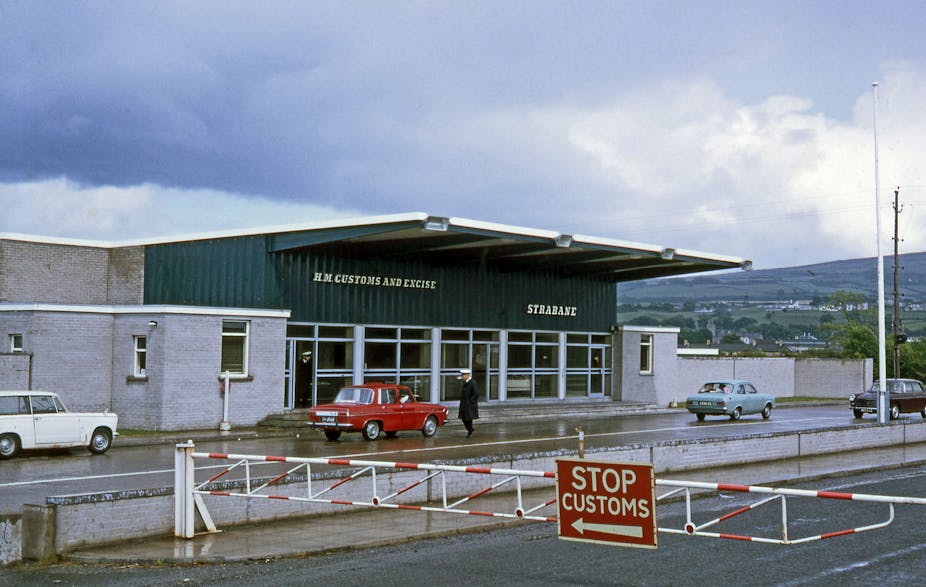How might the UK “take back control” of its borders without making the border in Ireland any harder. One proposal on the table is maximum facilitation (max fac). This approach does not avoid the creation of a customs border between Northern Ireland and the Republic of Ireland but rather aims to make the border as invisible and frictionless as possible through the use of technology. This includes electronic customs registration, unobtrusive screening techniques and even the technology behind Bitcoin.
But the application of technology cannot sugarcoat the fact that being outside the customs union will have a material impact on the Irish border. Such an impact jars with the UK government’s commitment that the Irish border would have “no physical infrastructure or related checks or controls”. For it is absolutely clear what a UK-EU customs border would mean. Goods moving between the two would be subject to customs supervision and this means checks and controls.
Electronic customs
Custom authorities around the world are keen to find technological means of improving efficiency. Paper forms have steadily been replaced by electronic customs declarations, which can be submitted more easily and enable quicker movement between different customs zones. For this reason, both the UK and the EU are in the process of creating fully electronic customs systems.
Singapore has just revealed the world’s first blockchain-based platform for electronic certificates of origin (eCOs). Blockchain is a way of recording transactions on a decentralised public register that’s very hard to tamper with, and is the technology behind bitcoin. Verification of eCOs through a private blockchain network helps prevent fraud and alterations of certificates of origin. This could address one issue that the UK and the EU face.
But this doesn’t go anywhere near resolving the risk of customs fraud on the Irish border. The difficulty of policing this border was exploited by smugglers even when it was heavily securitised.
More fundamentally, any solution would have to address the historical, economic and geographical realities of the Irish border, as well as its political and social significance.
Read more: The Good Friday Agreement in Northern Ireland at 20 – The Anthill podcast
Gathering Information
The effectiveness of maximum facilitation in customs enforcement stands or falls on the scale and quality of the information the systems receive. This type of border control requires operators and travellers to pre-register for customs checks and constantly disclose accurate information to all relevant parties.
When vehicles pass through approved crossings, officials can track the progress of registered vehicles (albeit without knowledge of what they are carrying). If used on a mass scale, big data can be be used to identify patterns of suspicious activity.
It is also possible to gather information that is not willingly – nor wittingly – submitted by those crossing the border. Sensors buried in the ground or micro synthetic aperture radar on drones in the air could detect unexpected vehicle movement across a border.

Such technology may have its uses in unpopulated, inhospitable plains where border crossings are almost automatically suspect. But as a means of monitoring a border that is literally criss-crossed with small roads and straddled by farms, households and parishes, it is as redundant as it is offensive.
Just think how the residents of Dover or Holyhead would respond to the idea of being constantly surveilled by drones or mobile phone tracing. Those in the Irish border region have recent experience of close surveillance and border controls. Twenty years on from the Good Friday (Belfast) Agreement, the negative consequences of militarised security at the Irish border remain evident: economically, socially and politically.
It is absolutely critical to appreciate that the achievement of a porous, unmonitored Irish border is a much-cherished sign of the peace process. Hence the promise to avoid a hard border.
Checking goods
Another concern about customs checks is the question of how these might occur. Goods container inspections require physical infrastructure and human resources. Experience on the Irish border shows that routine customs inspections can escalate into serious operations requiring security protection. Politicians hope technology can alleviate this.
There have been steady advances in non intrusive screening techniques. Vapour analysis using what’s known as neutron-activated spectroscopy could enable customs to detect the presence of certain chemical compounds. Gamma ray scanning can be used to give a type of x-ray image of what is inside a container, while Muon tomography can help customs assess the volume and location of contents in a container.
But these technologies are very expensive and impractical. They are designed for a particular task, such as detecting a specific type of contraband, and are neither speedy nor invisible.
Human checks on goods will remain critical to customs supervision. At the very least this will require warehouses large enough to inspect freight. Locating them away from the border does not mean no border controls, only less effective ones. For the further from the border these are located, the greater the opportunity for cargo to be swapped or stolen.
Sugar coating the real problem
Maximum facilitation can do no more than its name suggests – facilitate customs procedures. It cannot end the need for customs checks. In fact, it relies upon them.
The more hidden the technology monitoring a customs border is, the greater the need for surveillance and data capture. Movements, transactions and communications across the Irish border are a precious part of everyday life for so many in Ireland, north and south. To gather data on such movements, transactions and communications for the purpose of enforcing a customs border that no one in Northern Ireland wishes to see is hardly a viable (let alone democratic) solution.
Max fac could certainly conjure up more efficient and surreptitious border controls than have previously existed between the UK and Ireland. But the sugar-coating of technology would hardly last long before the bitter reality of enforcing a UK-EU customs border in Ireland was revealed.

